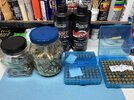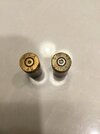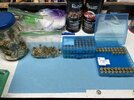CQB45ACP
Member
This is just informational for any of you interested.
Since late spring-early summer, I’ve been loading from the same batch of Winchester cases. This was primarily out of curiosity to see how long the cases would last before splitting, etc.
This is not/was not intended to be a strictly controlled scientific analysis—it’s out of curiosity.
Being a former government bureaucrat, there has been plenty of scope creep as I tested.
Not too long after I started, my test expanded to include watching for case shortening and primer pocket gauging after each use. This article was a contributing cause—http://www.floridareloading.com/index.php/2017/02/04/how-many-times-can-i-reload-45-acp-brass/
I measured case length and arbitrarily stopped loading cases under .893” So, my total case universe dropped considerably.
The photo below from left to right shows four sub-batches of cases—under .890”, .891-.892”, .893”, and .894” and over. Again, I’m now only loading from the last two and they’re being depleted noticeably due mostly to case loss and not shortening (my strong suspicion but not swearing to it).
I shoot about 100 of these per week and estimate each case has been used a half-dozen times. They had been used an untold number of times before the test began. They’ve been 230gr plated RN at 1.260” or Acme coated at 1.250” using either 5.2gr W231 or 4.5gr Bullseye. So, light loads.
Undersized die, no expanding, no crimp for plated (another scope creep).
Bottom line—some primer pockets seem tighter NOT looser, none seem looser, and NO cases have split.
I can think of a number of improvements to this process and likely will hear some more from you. No offense but it’s unlikely I’ll do any that require more effort on my part

Since late spring-early summer, I’ve been loading from the same batch of Winchester cases. This was primarily out of curiosity to see how long the cases would last before splitting, etc.
This is not/was not intended to be a strictly controlled scientific analysis—it’s out of curiosity.
Being a former government bureaucrat, there has been plenty of scope creep as I tested.
Not too long after I started, my test expanded to include watching for case shortening and primer pocket gauging after each use. This article was a contributing cause—http://www.floridareloading.com/index.php/2017/02/04/how-many-times-can-i-reload-45-acp-brass/
I measured case length and arbitrarily stopped loading cases under .893” So, my total case universe dropped considerably.
The photo below from left to right shows four sub-batches of cases—under .890”, .891-.892”, .893”, and .894” and over. Again, I’m now only loading from the last two and they’re being depleted noticeably due mostly to case loss and not shortening (my strong suspicion but not swearing to it).
I shoot about 100 of these per week and estimate each case has been used a half-dozen times. They had been used an untold number of times before the test began. They’ve been 230gr plated RN at 1.260” or Acme coated at 1.250” using either 5.2gr W231 or 4.5gr Bullseye. So, light loads.
Undersized die, no expanding, no crimp for plated (another scope creep).
Bottom line—some primer pockets seem tighter NOT looser, none seem looser, and NO cases have split.
I can think of a number of improvements to this process and likely will hear some more from you. No offense but it’s unlikely I’ll do any that require more effort on my part




